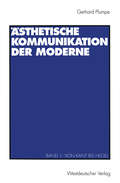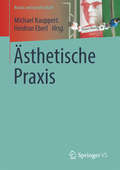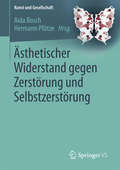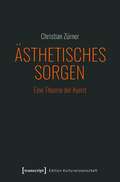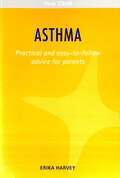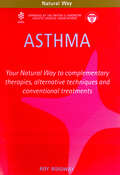- Table View
- List View
Ästhetische Geschichtserkenntnis: Historische Erinnerung im filmischen Werk Andres Veiels (Histoire #197)
by Andre BartoniczekMit seinen preisgekrönten Filmen dringt Andres Veiel immer wieder zu den Hintergründen deutscher Geschichte vor. Kennzeichnend für seinen Ansatz sind die ästhetischen Verfahrensweisen, durch die er einen originären Beitrag in der langen Tradition der Auseinandersetzung zwischen wissenschaftlicher und künstlerischer Aneignung von Geschichte leistet. Andre Bartoniczek arbeitet die Signaturen dieser Tradition auf, zeichnet die Entwicklung des Dokumentarfilms nach und liefert als erste umfangreiche Untersuchung Veiels geschichtlicher Filme eine Werkanalyse, die letztlich der Frage nachgeht: Was ist und wie gelingt historische Erinnerung? Dabei kommt auch der Filmemacher selbst zu Wort.
Ästhetische Gesichtschirurgie
by Juarez M. AvelarDie Rhytidoplastik – oder Gesichtsstraffung - ist ein Verfahren, bei dem Gesichtsfalten chirurgisch entfernt werden, um ein jugendlicheres Aussehen zu erreichen. In diesem Buch, das von führenden brasilianischen und internationalen Spezialisten verfasst wurde, wird eine Vielzahl von Themen rund um die Gesichtsverjüngung erörtert. Die ersten Abschnitte behandeln die chirurgische Planung, psychologische Betrachtungen und die Vorbereitung des Patienten. Mit berücksichtigt werden anatomische und biochemische Veränderungen, die durch den Alterungsprozess verursacht werden. Außerdem wird die chirurgische Anatomie von Stirn, Gesicht, Hals und Augenlidern beschrieben. Der dritte Abschnitt bietet einen umfassenden Überblick über die grundlegenden Techniken des Faceliftings mit Einzelheiten zu verfeinerten chirurgischen Ansätzen für das gesamte Gesicht und den Hals. Es werden Techniken der Fettabsaugung, der Lipoinjektion sowie der Übertragung von Stammzellen vorgestellt und ihre Bedeutungfür die Neugestaltung der Gesichtskonturen aufgezeigt. Es wird sowohl auf die Behandlung von Weichteilen als auch von kraniofazialen Knochenstrukturen eingegangen, um die Ästhetik des Gesichts zu verbessern. Weitere Themen sind die Narbenbildung nach dem Facelifting, minimalinvasive Verfahren als ergänzende Ansätze bei der Rhytidoplastik und die damit verbundenen Verfahren. Der letzte Abschnitt befasst sich mit der postoperativen Versorgung.Ästhetische Gesichtschirurgie besteht aus 64 Kapiteln, die sich auf alle Aspekte des Faceliftings konzentrieren, und beschreibt akribisch chirurgische Details, die in anderen medizinischen Büchern nicht behandelt werden. Mit zahlreichen Abbildungen, Fotos, Software und Videos ist es eine wertvolle Ressource für alle jungen und erfahrenen Chirurgen gleichermaßen.
Ästhetische Kategorien: Perspektiven der Kunstwissenschaft und der Philosophie (Linzer Beiträge zur Kunstwissenschaft und Philosophie #7)
by Monika Leisch-Kiesl Max Gottschlich Susanne WinderOhne viel zu überlegen sprechen wir von einem schönen Outfit, einer erhabenen Landschaft oder einer dichten Atmosphäre. Der mitunter inflationäre Gebrauch solcher ästhetischen Kategorien fordert sowohl die Kunstwissenschaft als auch die Philosophie heraus, deren Erschließungskraft neu zu erproben. Die Beiträge des Bandes nehmen acht gleichermaßen klassische wie zeitgenössische ästhetische Kategorien in den Blick: das Schöne, das Erhabene, das Hässliche, Nachahmung, Atmosphäre, Zeitlichkeit, Zeichen und Performativität. Deren mögliche Semantiken werden in einem vielversprechenden Wechselspiel von kunstwissenschaftlicher und philosophischer Reflexion geschärft. Mit Beiträgen von Julia Allerstorfer, Leo Dorner, Max Gottschlich, Stephan Grotz, Isabella Guanzini, Martin Hochleitner, Michael Hofer, Susanne Hofmann, Antonia Krainer, Monika Leisch-Kiesl, Wilfried Lipp, Wilhelm Lütterfelds, Dieter Mersch, Günther Pöltner, Andrei Pop, Barbara Schrödl, Christian Spies, Florian Uhl und Susanne Winder.
Ästhetische Kommunikation der Moderne: Band 1: Von Kant bis Hegel
by Gerhard PlumpeAuf die Ausdifferenzierung der Literatur und Kunst zu einem modernen Sozialsystem reagierte die Philosophie mit der Ausbildung ästhetischer Kommunikation. Deren Geschichte um 1800 wird als Versuch rekonstruiert, die "Autonomie" der Kunst als epochales Ereignis zu begründen, aber auch als Prämisse anspruchsvoller Leistungserwartungen zu überfordern, der Beobachtung sozialer Differenzierungsprozesse werden Mythen der Totalität im Medium der Kunsterfahrung entgegengestellt. Diese romantische Paradoxierung der Kunstautonomie wird in Hegels Ästhetik kritisch reflektiert und durch eine auch soziologisch orientierte Perspektive ersetzt, die der Partikularität moderner Kunst zu entsprechen sucht."(...) Angesichts der Komplexität des Themas und der analysierten philosophischen Positionen überzeugt Plumpes Darstellung durch Klarheit und Zugänglichkeit. Zur Einarbeitung in ästhetische Fragestellungen sowie als Hintergrundinformation zu allen mit der Entwicklung moderner Kunst befaßten Überlegungen ist Gerhard Plumpes 'Ästhetische Kommunikation der Moderne' daher unbedingt zu empfehlen."Literatur in Wissenschaft und Unterricht, XXVII/1-1994
Ästhetische Kommunikation der Moderne: Band 2: Von Nietzsche bis zur Gegenwart
by Gerhard PlumpeIn dem zweibändigen Werk "Ästhetische Kommunikation der Moderne" wird eine informative Übersicht über die wichtigsten Kunsttheorien von Kant bis in unsere Zeit gegeben, wie sie in Studium und Wissenschaft benötigt wird. An der systemtheoretisch orientierten Betrachtungsweise ergibt sich eine neue Periodisierung der Ästhetikgeschichte,die vergleichsweise wenige, aber markante Einschnitte anbringt und zur Diskussion stellt.Der zweite Band geht der Verwissenschaftlichung und Politisierung der Kunsttheorie im historischen Kontext der Avantgarde nach und thematisiert die Wiederkehr großer philosophischer Ästhetik in unserem Jahrhundert, die Leitmotive der romantischen Kunstphilosophie noch einmal aufnimmt.
Ästhetische Ordnungen und Politiken des Wohnens: Häusliches und Domestisches in der visuellen Moderne (wohnen+/-ausstellen #9)
by Irene Nierhaus Kathrin HeinzWohnen ist geprägt von Vorstellungswelten, die in bildlichen und räumlichen Medien entworfen werden. Seit 1800 werden Beziehungen zwischen Bewohner*innenschaft, Räumlichkeit und Dingen als identitätsproduzierende Verhältnisse und gemeinschaftsbildende Prozesse formiert, ästhetisch gestaltet und in verschiedenen Bildsorten, Genres, Bildstrategien und visuellen Verfahren hervorgebracht. Die Beiträger*innen des Bandes fragen nach Zusammenhängen von Bildprozessen und Bedeutungsproduktionen und -verschiebungen im Domestischen und Häuslichen. Sie diskutieren das Mannigfaltige wie das Reproduktive, das Innovative wie das Affirmative des Ästhetischen - und damit die Potenzialität des Bildlichen im Wohnen.
Ästhetische Praxis (Kunst und Gesellschaft)
Die bis in unsere Gegenwart hineinreichende Gewissheit, dass es sich bei ästhetischer Praxis um die Praxis von Künstlern und die Wahrnehmung von Kunst durch ein Publikum handeln müsse, ist brüchig geworden. Eine Reihe von Indizien legen den Schluss nahe, dass der Bereich ästhetischer Praktiken und das Kunstfeld in der Gesellschaft eine nur noch partiale Deckung aufweisen. Beispiele für ästhetische Praktiken finden sich in der Mode, der Werbung und dem Design ebenso wie in den neuen Medien sowie in der Musik- und Videospielindustrie. Aber auch Kosmetik-Ketten und Parfümerien, Schönheitschirurgen, Tätowierungsshops, Büros für Inneneinrichtung- und Landschaftsarchitektur, Blumenläden sowie Wellnessbetriebe annoncieren ihre Produkte und Dienstleistungen als ästhetisch. Angesichts des sowohl rasant steigenden Gebrauchs des Adjektivs „ästhetisch“ in der alltäglichen Lebenspraxis als auch des vermehrten wissenschaftlichen Bedürfnisses, das „Ästhetische“ an (bis dato) unverdächtigen Stellen in der Gesellschaft nachzuweisen, sind die Beiträge dieses Bandes entlang einer Leitfragestellung organisiert: Soll man das verstärkte Aufkommen ästhetischer Praktiken in der Gesellschaft in einer eher kulturwissenschaftlichen und -soziologischen Perspektive verstehen und also als eine „Selbstentgrenzung der Künste“? Oder zieht man dazu besser eine zwar nur äußerst selten gebrauchte, nichtsdestotrotz ebenso einprägsame wie aufschlussreiche Formel Adornos heran und begreift die Ästhetisierung der Gesellschaft als eine „Entkunstung der Kunst“?
Ästhetischer Widerstand gegen Zerstörung und Selbstzerstörung (Kunst und Gesellschaft)
by Aida Bosch Hermann PfützeIn verschiedenen Beiträgen dieses Bandes wird soziologisch und ästhetisch, kunst- und literaturwissenschaftlich erörtert, wie aus ästhetischen Erfahrungen Widerstandskraft gegen Zerstörung und Selbstzerstörung entwickelt wird. Es wird gezeigt, dass Kunst und Gesellschaft nicht ohne ästhetischen Widerstand zu machen sind. Dieser äußert sich nicht nur in der Produktion und in der Rezeption von Kunst, sondern auch in vielfältigen Praxen der Lebenswelt. Welche Rolle spielt ästhetische Erfahrung heute für die Fragen des guten Lebens und wie ist Ästhetik mit dem Leben selbst verbunden? Wie kann das Verhältnis von Ethik und Ästhetik heute gesellschaftlich und politisch gedacht und vermittelt werden? Und vor allem: Wie kann der Destruktionsdynamik als Sucht und Sog gesellschaftlicher Selbstzerstörung durch ästhetischen Widerstand wirksam Einhalt geboten werden?
Ästhetisches Sorgen: Eine Theorie der Kunst (Edition Kulturwissenschaft #241)
by Christian ZürnerÄsthetik reflektiert Kunst, kaum aber deren konkrete Verwendungsformen. Um zu verstehen, was Kunst ist, muss sie jedoch als spezifische Situationen konstituierende besondere Praxis untersucht werden. Kunst ist kein Erkennen oder Erfahren, sondern strategisches Tun: Als (feierliches) ästhetisches Sorgen kultiviert sie in öffentlichen wie privaten Kontexten eine Praxis existenziellen kultischen Sorgens. Christian Zürner hinterfragt ästhetische Topoi wie Autonomie und (Zweck-)Freiheit angesichts solch immanenter Notwendigkeit ebenso wie normative philosophische Zuschreibungen. Kunst bedeutet keinen souveränen Überschuss, sondern lebt vom Drang, menschliche Existenz in einer unheimlichen Welt überhaupt erst einzurichten.
Ästhetisches Verhalten: Anthropologische Studien zu einem Grundbegriff philosophischer Ästhetik
by Volker SchmidtÄsthetisches Verstehen Und Nichtverstehen: Aktuelle Zugänge In Literatur- Und Mediendidaktik (Lettre Ser. #2)
by Hendrick Heimböckel Jennifer PavlikVerstehen und Nichtverstehen sind kulturwissenschaftliche und ideengeschichtliche Leitbegriffe. Je nach theoretischer Ausrichtung und Erkenntnisinteresse schließen sie sich aus, ergänzen sich oder bauen aufeinander auf. Während Verstehensansätze zum literaturdidaktischen Instrumentarium gehören und die Forschung zum Nichtverstehen stärker in Literatur- und Kulturwissenschaft angesiedelt ist, erkunden die vielstimmigen Perspektiven dieses Bandes, ob und inwiefern die Vermittlung von Verstehen und Nichtverstehen in literatur- und mediendidaktischen Fragestellungen möglich ist.
Asthma (The Facts)
by S. Hasan Arshad K. Suresh BabuAsthma is a common chronic inflammatory condition of the airways which causes coughing, wheezing, shortness of breath and tightness of the chest. Asthma attacks can be triggered by exposure to allergens, physical exertion, stress, or can be aggravated as a result of common coughs and colds. Over 5 million people in the UK and over 6% of children in the US suffer from Asthma, and a recent increase in prevalence is thought to be attributed to our modern lifestyle, such the changes in housing, diet and a more hygienic environment that have developed over the past few decades. Asthma: The Facts is a practical guide to asthma, suitable for those who suffer from asthma, their families, and the health professionals that treat them. It details how a diagnosis of asthma is reached, and what treatments are available to successfully manage the condition and prevent attacks on a day-to-day basis. The book contains advice on proactive changes which can be made to lifestyles, such as avoiding allergens, as well as how to cope with an attack, and how to administer the relevant treatment effectively. The authors conclude that whilst there is currently no cure for asthma, by taking a proactive, self-directed approach to management, its impact on the patient and their lives can be significantly reduced.
Asthma (The Facts)
by S. Hasan Arshad K. Suresh BabuAsthma is a common chronic inflammatory condition of the airways which causes coughing, wheezing, shortness of breath and tightness of the chest. Asthma attacks can be triggered by exposure to allergens, physical exertion, stress, or can be aggravated as a result of common coughs and colds. Over 5 million people in the UK and over 6% of children in the US suffer from Asthma, and a recent increase in prevalence is thought to be attributed to our modern lifestyle, such the changes in housing, diet and a more hygienic environment that have developed over the past few decades. Asthma: The Facts is a practical guide to asthma, suitable for those who suffer from asthma, their families, and the health professionals that treat them. It details how a diagnosis of asthma is reached, and what treatments are available to successfully manage the condition and prevent attacks on a day-to-day basis. The book contains advice on proactive changes which can be made to lifestyles, such as avoiding allergens, as well as how to cope with an attack, and how to administer the relevant treatment effectively. The authors conclude that whilst there is currently no cure for asthma, by taking a proactive, self-directed approach to management, its impact on the patient and their lives can be significantly reduced.
Asthma: Clinician's Desk Reference
by J Douglas Kurtis ElwardAs the series title implies each Clinician's Desk Reference is a practical resource and a daily aid for physicians in the hospital setting and in primary care.Asthma is one of the most important chronic disorders in the developed world. Evidence from around the world shows the prevalence of asthma has increased considerably since 1975, and now affe
Asthma: Methods and Protocols (Methods in Molecular Biology #2506)
by Magdalena M. GorskaThis volume details a collection of laboratory protocols to study asthma in mice and humans. Chapters cover animal models of asthma, methods to measure asthma-related molecules, protocols to detect, isolate, culture and stimulate cells that contribute to asthma in mice and humans, methods to deplete these cells in vivo and study responses of intact airway tissues ex vivo. Written in the format of the highly successful Methods in Molecular Biology series, each chapter includes an introduction to the topic, lists necessary materials and reagents, includes tips on troubleshooting and known pitfalls, and step-by-step, readily reproducible protocols. Authoritative and cutting-edge, Asthma: Methods and Protocols aims to be a foundation for future studies and to be a source of inspiration for new investigations in the field.
Asthma
by Erika HarveyAsthma is a frightening condition for both parents and children. It can lead to enormous restrictions and greatly affect a child’s development physically, emotionally and socially.
Asthma: Critical Debates (Challenges In)
by Stephen T. Holgate Sebastian L JohnstonAsthma is one of the most important diseases affecting our society. It is an extremely common condition that reduces quality of life, and acute exacerbations can be life-threatening. It affects a disproportionate number of children. With the overwhelming volume of research being carried out in this field specialists need a method of keeping up-to-date with current opinion. As with the other 'Challenges' books, 'Challenges in Asthma' is aimed at hospital specialists and therefore assumes a certain level of knowledge about the disease. It builds on this by discussing only areas of controversy and uncertainty in both the basic understanding of asthma and its management. An international author list will provide stimulating debate with, and ultimately draw some conclusions from, existing data which will benefit readers in their day-to-day practice.
Asthma: Mechanisms And Protocols (Methods in Molecular Medicine #44)
by K. Fan Chung and Ian AdcockAsthma has rapidly become one of the most common chronic illnesses of the Western world, and its prevalence continues to rise, with the proportion of patients with more severe diseases also increasing. Faced with this problem, more researchers are focusing on the causes, mechanisms, and pathophysiology of asthma. The major hopes are that more effective drugs will become available and that preventive measures can be instituted. Increasingly, molecular and cell bi- ogy approaches are being used to characterize and understand the mechanisms of the inflammatory process that is typical of the asthmatic airway. This volume on Asthma: Mechanisms and Protocols in the Methods in Molecular Medicineseries provides an overview of the molecular mechanisms involved in asthma by p- viding extensive protocols that are being used in asthma research. Briefly, it c- ers details of methods for obtaining cells from the airways, analysis of gene and protein expression in the limited clinical samples from asthmatic airways, use of molecular and cellular tools for studying cytokine expression and release, studies of asthma-related genes and genetic polymorphisms, and understanding the - fects of asthma treatments. With such coverage, the volume ties in several dis- plines, including allergy and immunology, cell biology, pharmacology, and histology. We have continued in the spirit of the series to provide a bench book for day-to-day use.
Asthma: Structural Basis — Theophylline Today / Strukturelle Grundlagen — Theophyllin heute
by Friedrich KummerAsthma: Comorbidities, Coexisting Conditions, and Differential Diagnosis
by Richard F. Lockey Dennis K. Ledford WaoAsthma sufferers number approximately 200 million worldwide, with 15-20 million of those in the United States. Multiple comorbid conditions occur with asthma, including rhinitis, rhinosinusitis, gastroesophageal reflux disease, sleep apnea, vocal cord dysfunction syndrome, obesity, and chronic obstructive pulmonary disease (COPD). Without identifying and caring for comorbid conditions, asthma cannot be treated appropriately. Comorbidity of allergic diseases emphasizes that we must understand more about why different organs in individuals express allergy and others do not. The increase in multiple allergies occurring in a single patient makes the global burden even more complex, and an integrated approach to diagnosis and new treatment strategies and preventative approaches are required. Asthma: Comorbidities, Coexisting Conditions, and Differential Diagnosis is the first volume to provide a centralized, a comprehensive clinical reference on the diagnosis and management of the comorbid conditions that affect asthma. Because comorbid conditions of asthma have not yet been included in international and national management guidelines, this volume will help fill a gap in current clinical knowledge, aiding physicians in delivering optimal patient care. Written and published in conjunction with the World Allergy Organization (WAO), this book consists of the latest research and reviews of current theory and practice, the most effective advances in the diagnosis and management of asthma and its co-morbidities, and insights into the fundamentals of asthma and its co-morbidities. It presents scientifically-based medicine for each comorbid condition as it relates to asthma.
Asthma: Targeted Biological Therapies
by Girolamo Pelaia Alessandro Vatrella Rosario MaselliThis book focuses on the fundamentals of the use of biologics in asthma, describing the rationale, principles, mechanisms of action, and indications. It offers an excellent balance between basic science and the analysis of clinical trials, updating readers with new developments that are changing the global scenario for targeted biological anti-asthma therapies, especially with regard to more severe disease. A range of therapies are considered, from the humanized monoclonal anti-IgE antibody omalizumab, widely approved as add-on treatment for inadequately controlled disease, through to emerging biologics for which evidence supportive of efficacy is accumulating, including anti-IL-5, anti-IL-4, and anti-IL-13 therapies. One aspect to emerge is the variability in individual response, which suggests a need for characterization of different asthma subtypes to permit the effective implementation of phenotype-targeted treatments. This book will be of interest for pulmonologists, clinical immunologists, and physicians seeking sound information on these therapies, but also for scientists and pharmacologists wishing to enhance their knowledge of the therapeutic implications of the cellular and molecular mechanisms that underlie severe, uncontrolled asthma.
Asthma
by Roy RidgwayAsthma affects millions of people worldwide and the numbers, especially of children, are increasing at an alarming rate. A severe attack can be fatal. Conventional medicine often seems powerless to help – and may even be making the situation worse.
Asthma: Grundlagen — Diagnostik — Therapie
by Gerhard Schultze-Werninghaus M. DebelicDas Interesse an pulmonalen Erkrankungen, besonders an Asthma, hat sich in den vergangenen Jahren in erheblichem Maße verstärkt, bedingt durch Hinweise auf eine zunehmende Häufigkeit derartiger Krankheitsbilder und durch die Annahme eines Zusammenhanges mit den Umweltbedingungen in der Industriegesellschaft. Asthma ist eine vielschichtige Krankheit - Ätiologie, Pathophysiologie, Klinik und Befunde sind uneinheitlich - die in der verfügbaren Literatur in unterschiedlicher Weise abgehandelt wird. In diesem Buch beschreiben 26 Autoren das Krankheitsbild Asthma unter dem aktuellen Gesichtpunkt der Entzündung der Atemwege und der daraus resultierenden Hyperreagibilität. Der Schwerpunkt liegt dabei auf der nervösen und neurohumoralen Regulation, den Grundlagen der Hyperreagibilität sowie Diagnostik und Therapie. Das Buch ist sowohl für den niedergelassenen Arzt als auch den Krankenhausarzt eine umfassende Informationsquelle über das aktuelle Krankheitsbild.



